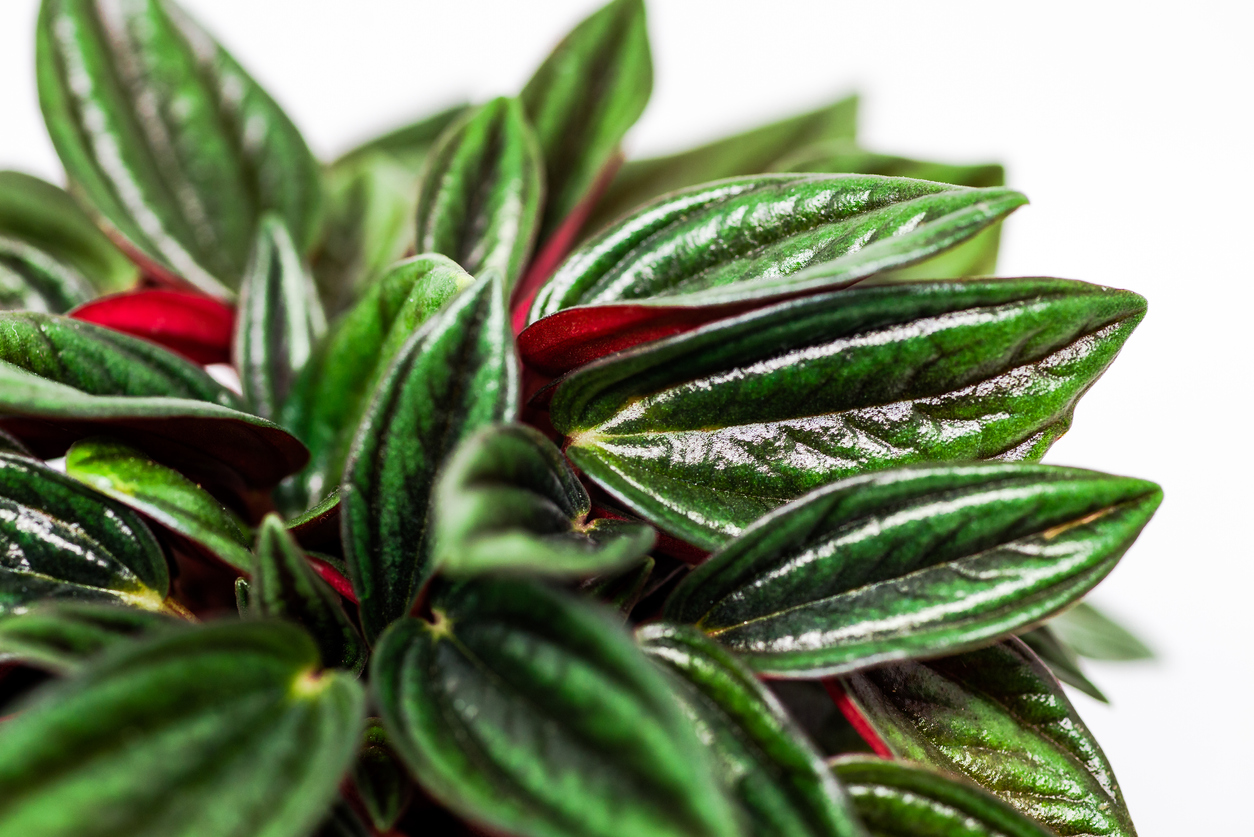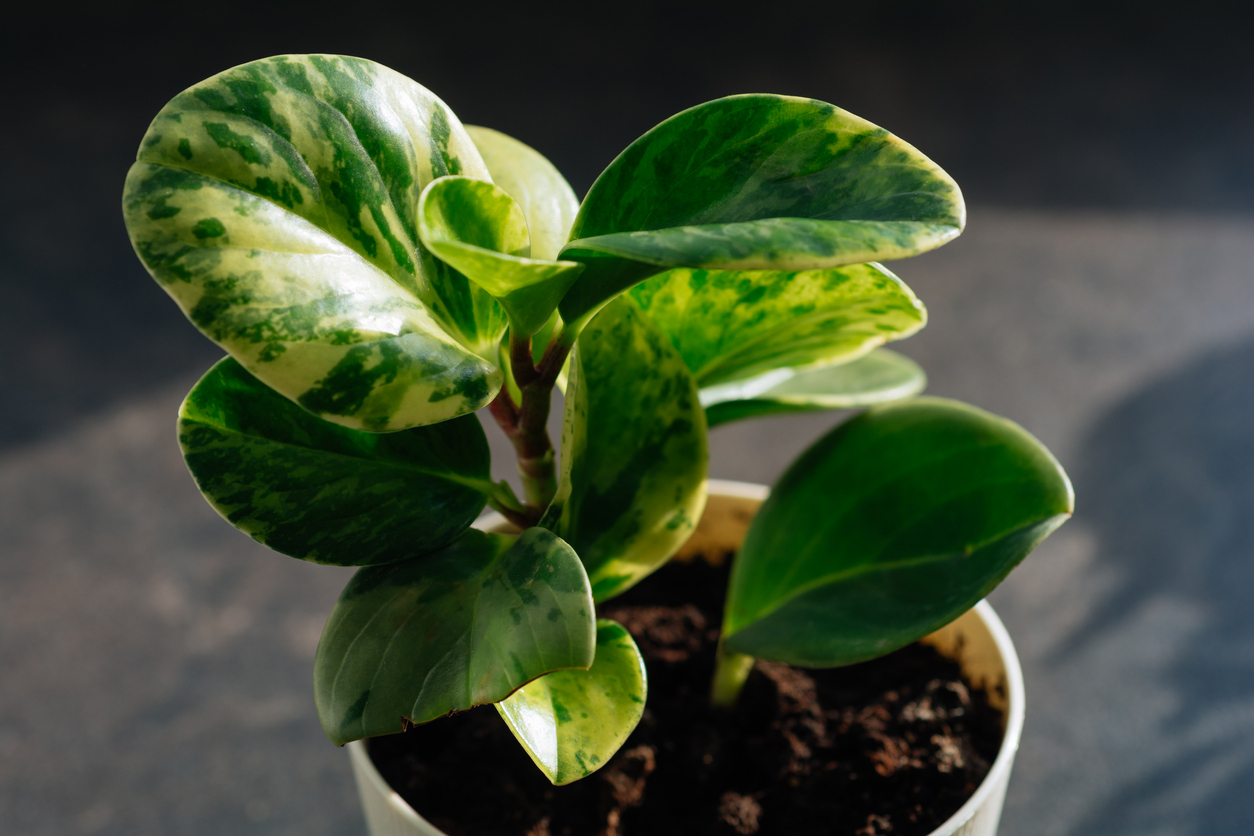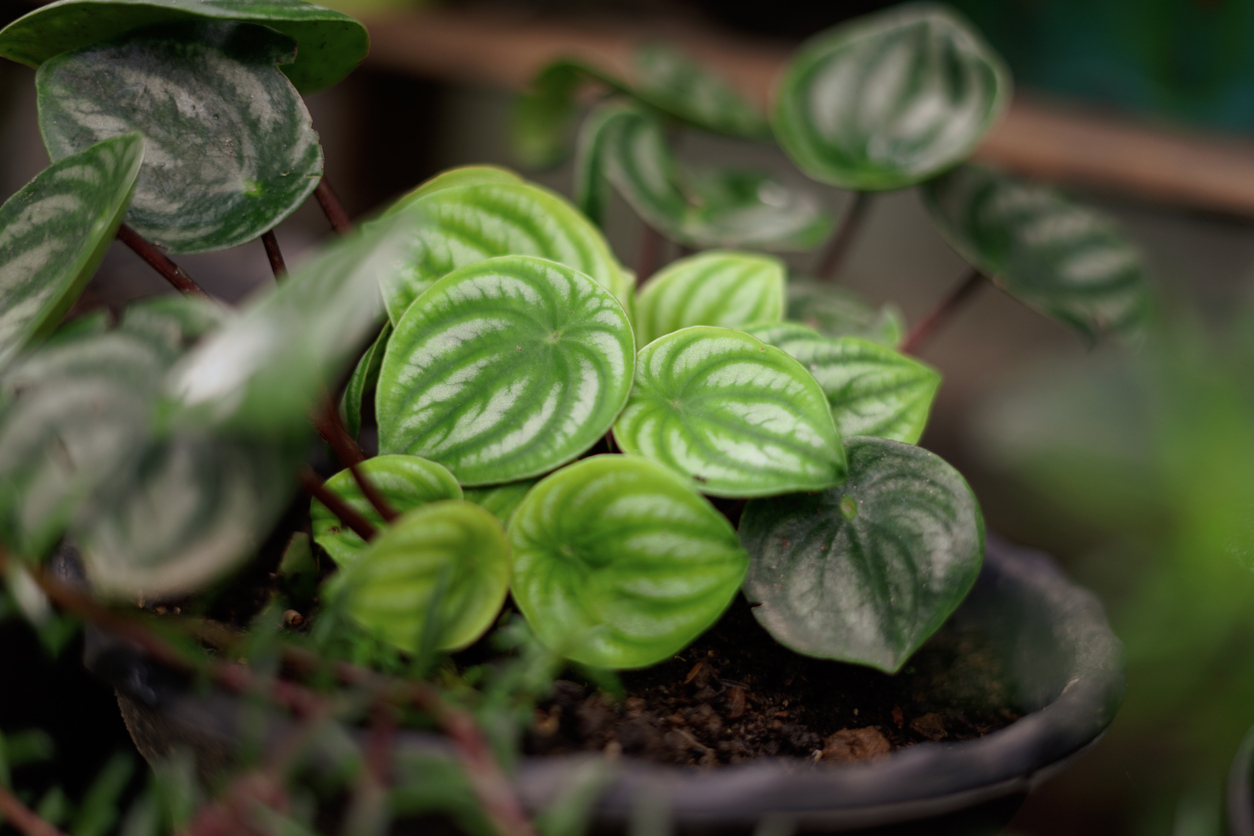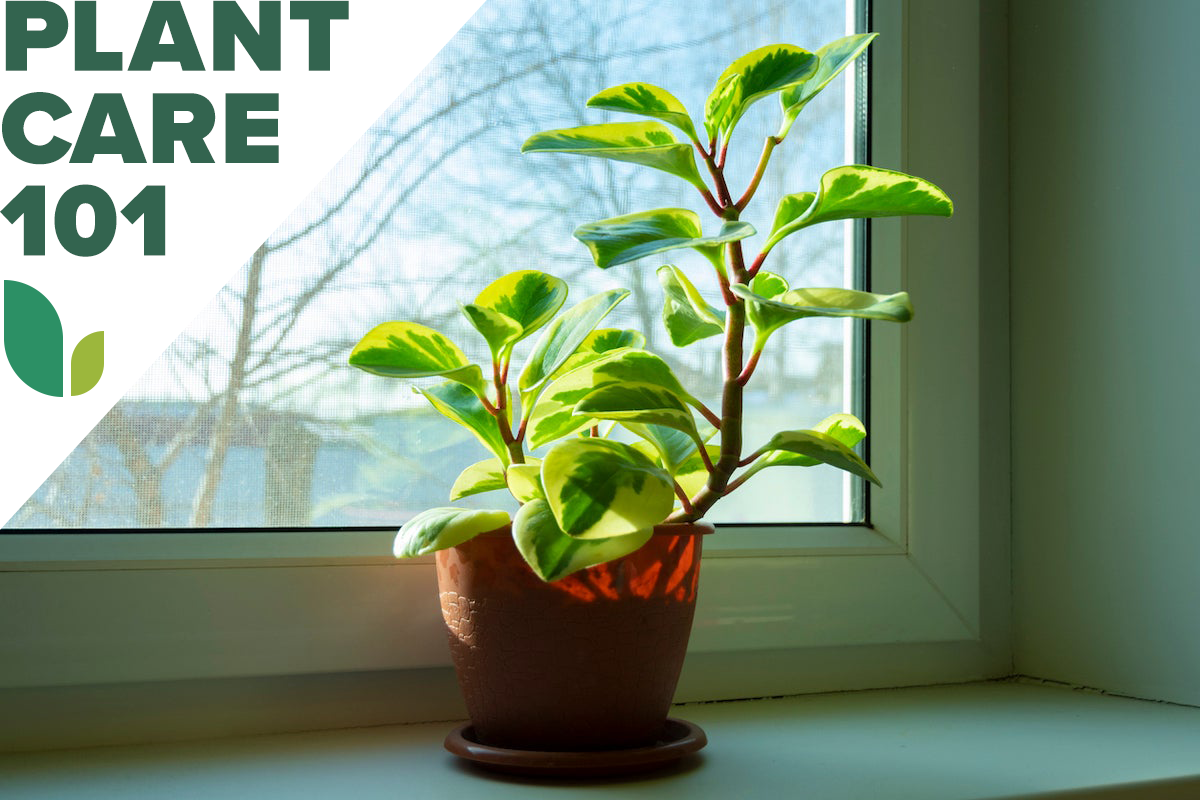We may earn revenue from the products available on this page and participate in affiliate programs. Learn More ›
The peperomia plant derives its name from its resemblance to Piper nigrum, the vine from which peppercorns are harvested. However, peperomias vary widely. Some, indeed, are vines, but others form rosettes or more upright plants. One may sport intricately corrugated foliage and another display watermelon-striped leaves, while yet another resembles a baby rubber plant. There even are a few that look like pudgy cacti—minus the thorns!
So even though peperomias aren’t really pepper, they definitely can spice up your houseplant collection. Fortunately, for even the fanciest types, peperomia care is easy.
Peperomia Care at a Glance
Common Name: Peperomia
Scientific Name: Peperomia spp.
Soil: Potting mix with bark/perlite
Light: Bright indirect or east window
Water: Moderate
Food: Balanced houseplant fertilizer
Temperature and Humidity: Room temperature, moderate humidity
Propagation: Cuttings
Safety: Nontoxic to mildly toxic
Peperomia Characteristics
Most peperomias originated in South American rainforests, growing as epiphytes on trees or fallen logs beneath the forest canopy. This means they will tolerate low light but not soggy soil since they don’t grow naturally in soil. However, a few types of peperomia such as P. columella and P. hutchinsonii come from mountainous regions where they receive much more sun and much less water than the other species do.
As mentioned, peperomias vary so much that no one description will fit all of them, though most are on the small side—some growing no taller than 8 inches, with few surpassing 20 inches in height. What they do have in common is that most produce only minuscule greenish-white flowers on spikes that resemble rat tails and that appear in late summer or early autumn. So they are grown for their foliage rather than their blooms, with the exception of Peperomia fraseri, which offers bottlebrush-type flowers.
Types of Peperomia
- Peperomia ‘Frost’: This “cold-hearted” cultivar boasts heart-shaped leaves frosted with silver.
- Peperomia ‘Hope’: Also known as “trailing jade,” this vining variety has roundish green leaves carried in clusters and marked with slightly lighter green stripes.
- Peperomia obtusifolia: Sometimes called “baby rubber plant,” this species resembles a miniature rubber plant with its roundish glossy leaves but short stature.
- Peperomia ‘Peppermill’: This peperomia offers heart-shaped leaves with veins that are peppered with brown splotches.
- Peperomia ‘Red Twist’: The twist to this cultivar, also known as ‘Red Log,’ is the ruddy hue marking its stems and the undersides of its oval green leaves.

Selecting Soil for Peperomia Plants
Because so many peperomia types are epiphytes and grow on trees, without benefit of soil, they rot easily if their potting mix isn’t porous enough. Therefore, a soil that has been lightened with orchid bark and/or perlite will work best for them. Gardens Illustrated suggests a mix of two parts standard potting mix combined with one part orchid bark and one part perlite.
Terra-cotta pots should work better for peperomias than the plastic type since terra cotta allows some air to reach the plant’s roots. Just keep in mind that such porous pots dry out very quickly. And, although the most succulent peperomias can survive occasional parching, rainforest types may not.
The Right Light
Since most peperomias grow beneath a rainforest canopy in the wild, they generally prefer either bright indirect light, shade on a north-facing windowsill, or a position on an east-facing windowsill where they receive morning sun only. Don’t keep them too dark, however, but somewhere in the 100- to 500-foot candle range. Due to their usually small stature, they also can flourish beneath fluorescent grow lights.
According to Gardens Illustrated, mountainous species such as P. columella, P. ferreyrae, and P. hutchisonii prefer full sun such as that which illuminates an unshaded south-facing windowsill. However, even those species may need to be adapted to such conditions gradually if they weren’t exposed to that much light before.
Related: What Is “Bright, Indirect Light,” Anyway?
Watering Peperomias
Because peperomias are somewhat prone to root rot, don’t water them until their soil is dry ½ inch down for rainforest types, perhaps as far as 2 inches down for fully succulent types. Use rainwater or spring water, if possible, to avoid buildup of salts in the soil.
For rosette types, avoid soaking the crown of the plant with cold water, which can cause rotting. Instead pour room temperature water into the edge—rather than the center—of the pot or irrigate the plant from the bottom instead. (You can do that by setting it in a pan that contains an inch or so of lukewarm water until that water is taken up through the drainage holes enough to lightly moisten the surface of the soil.)
Fertilizing Peperomia Plants
Because they grow so slowly, peperomias don’t require much feeding. Some gardeners choose not to fertilize them at all, while others might opt to do so as often as once every couple of weeks during the growing season (spring through autumn).
If you choose the latter course, use only half the amount of plant food recommended. For example, should your 10-10-10 liquid houseplant food suggest ¼ teaspoon of extract per quart of water, use only ⅛ teaspoon instead.
It’s also a good idea to leach your plants’ containers every couple of months to get rid of excess salts. To do so, remove a plant’s pot from its saucer, place that pot in a sink with the drain unplugged or on the ground outdoors, and water the plant thoroughly enough that water trickles out the drainage holes at the bottom of the pot and down the drain or into the ground.

Setting the Temperature and Humidity
Peperomias prefer typical household temperatures between 65 and 75 degrees Fahrenheit but will tolerate conditions as low as 50 degrees—provided there are no drafts—and as high as 80 degrees. If you decide to place them outdoors in a shady, protected location over the summer, bring them in before temperatures drop below 50 degrees.
The less succulent rainforest types will appreciate being placed on a humidity tray or misted. Fully succulent types don’t require misting and may resent such steamy conditions, since they already are storing moisture in their foliage and a surplus could cause them to rot or develop edema blisters.
Propagating Peperomias
Rosette-type peperomias, in which the leaves circle a crown, should be propagated by leaf cuttings. Allow a stem at least 1 inch long to remain on each leaf you snip from the plant and bury the lower ½ inch of each stem in a container filled with damp and sterile seed-starting mix. Cover that container loosely with an upended plastic bag—held away from the cuttings with sticks—to help keep the mix moist.
Propagate other types of peperomias with 3- to 4-inch cuttings snipped from the plants’ tips, each severed just below a leaf node. Remove the lower leaves on each cutting, until only a couple of top ones remain, before inserting the cutting into your mix far enough that its lowest node is covered. Then proceed as you did for leaf cuttings, keeping in mind that most cuttings will take 3 to 4 weeks to root.
Related: 10 Houseplants You Can Propagate the Fastest for an Ever-Expanding Indoor Garden
Safety Considerations
Despite their comparison to the pepper plant, peperomia plants shouldn’t be eaten. However, they aren’t considered toxic to either pets or people unless consumed in very large amounts. Peperomia obtusifolia, for example, contains alkaloids and has been known to cause deaths in rodents when fed to them. But, as David Spoerke and Susan Smolinske note in Toxicity of Houseplants, “No human cases [of poisoning] could be found. Therefore, the risk is assumed to be low. Even in the animal experiments, it took a significant amount of plant material to cause symptoms and death.”
Peperomias with corrugated leaves could prove to be dust catchers, so gardeners with allergies probably should opt for the more easily cleaned glossy-leaf varieties instead.

Potential Pests and Diseases
When it comes to peperomia problems, think of yellowing foliage as a yellow light warning you to stop—stop watering so much, that is! Blisters on the undersides of leaves that burst to leave corky spots are a sign of edema and also indicate that a plant is receiving too much moisture.
Wilting foliage that turns brittle and brown may mean that your peperomia is getting too much sun or too little water. However, plants whose roots have completely rotted will also wilt. If you see insects resembling bits of cotton on a peperomia’s leaves, use a swab dipped in rubbing alcohol to eliminate those mealybugs.
Related: Solved! What Your Plants’ Yellow Leaves Mean, and How to Fix Them
FAQs
Yes. Most tolerate low light and infrequent watering with equanimity.
Not very fast. In The Unexpected Houseplant, Tovah Martin warns that you shouldn’t “expect your peperomia to do more than move just one step ahead of suspended animation.”
Some types can survive for 6 years or more, and indefinitely if they aren’t drowned by overwatering.
No. Most peperomias prefer bright indirect light or shade, though they may enjoy the gentle morning sun on an east-facing windowsill. See exceptions under “The Right Light” above.
Rainforest varieties enjoy misting, but those from more arid regions don’t require it.
Some types of peperomia are succulent and some are considered only semi-succulent.
Looking for more low-maintenance houseplants? Check out our guides on caring for air plant, peace lily, and snake plant.


